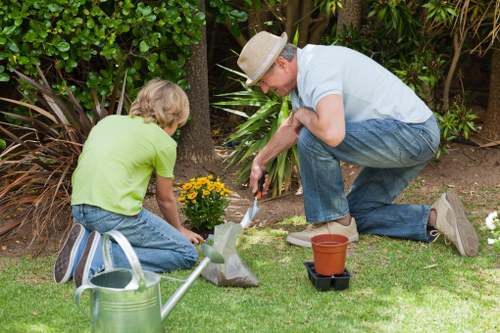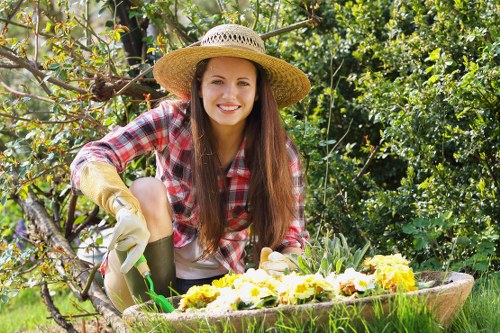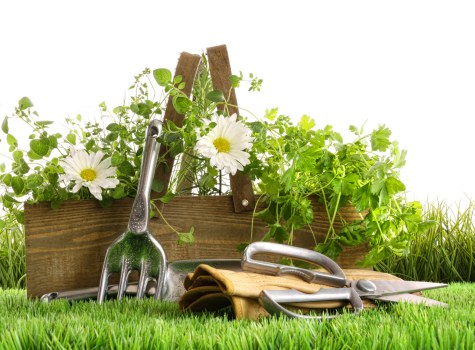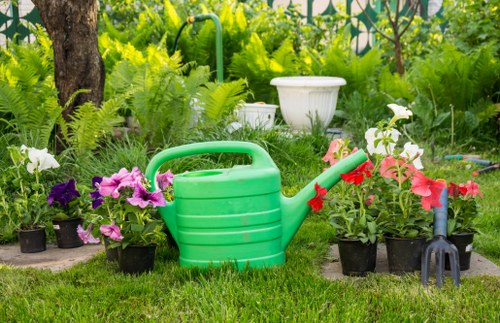Landscaping in St Johns Wood: Transforming Your Outdoor Spaces

Introduction to Landscaping in St Johns Wood
St Johns Wood, nestled in the heart of London, is renowned for its picturesque streets and lush greenery. Landscaping in this prestigious area goes beyond mere aesthetics; it's about creating harmonious outdoor spaces that complement the elegant residences and vibrant community. Whether you're looking to enhance your garden, design a new outdoor area, or maintain your existing landscape, understanding the unique aspects of landscaping in St Johns Wood is essential.
With its varied climate and soil conditions, St Johns Wood offers both opportunities and challenges for homeowners and professional landscapers alike. From selecting the right plant species to implementing sustainable practices, landscaping in this area requires a tailored approach to ensure lasting beauty and functionality.
In this comprehensive guide, we'll explore the key elements of successful landscaping in St Johns Wood, including design principles, plant selection, maintenance tips, and the latest trends that can elevate your outdoor living experience.

Understanding the Local Climate and Soil
Climate Considerations
St Johns Wood experiences a temperate maritime climate, characterized by mild winters and warm summers. This climate supports a diverse range of plant species, but it's crucial to select plants that can thrive in these conditions. Understanding factors such as average rainfall, temperature fluctuations, and sunlight exposure will help in creating a resilient landscape.
Soil Composition
The soil in St Johns Wood varies, with areas of clay, loam, and sandy compositions. Conducting a soil test is recommended to determine pH levels, nutrient content, and drainage capacity. This information is vital for choosing appropriate plants and amending the soil to improve fertility and structure.
Common Soil Amendments
- Compost: Enhances soil fertility and structure.
- Peat Moss: Improves moisture retention.
- Perlite: Increases drainage and aeration.
- Sand: Adjusts soil texture for better drainage.

Design Principles for Elegant Landscapes
Balance and Harmony
Creating a balanced landscape involves distributing visual weight evenly across the garden. This can be achieved by pairing large plants with smaller ones, using symmetrical arrangements, and ensuring that all elements complement each other. Harmony is about selecting elements that work together to create a cohesive and pleasing environment.
Focal Points
Incorporating focal points such as a stunning tree, a water feature, or a sculpture can draw attention and add character to your landscape. These elements serve as anchors around which the rest of the garden is organized, providing structure and interest.
Types of Focal Points
- Water Features: Fountains, ponds, and waterfalls add movement and tranquility.
- Flower Beds: Vibrant blooms create color and attract pollinators.
- Outdoor Lighting: Highlights architectural features and paths.
- Sculptures and Art: Personalize your garden with unique pieces.

Plant Selection for St Johns Wood Gardens
Choosing the Right Plants
Selecting plants that thrive in the local climate and soil conditions is crucial for a successful landscape. Consider factors such as growth rate, size, maintenance requirements, and aesthetic appeal when choosing flora for your garden.
Popular Plant Species
St Johns Wood's gardens benefit from a mix of evergreen and deciduous plants, perennials and annuals, providing year-round interest and diversity. Some popular choices include:
- Roses: Classic blooms that add romance and color.
- Lavender: Aromatic and attracts beneficial insects.
- Boxwood: Versatile for hedges and topiary.
- Hostas: Shade-tolerant with lush foliage.
- Japanese Maple: Adds structure and stunning fall color.
Native vs. Exotic Plants
While exotic plants can add unique visual interest, native species are often more resilient and require less maintenance. Balancing both can create a vibrant and sustainable garden.
Benefits of Native Plants
- Adapted to local climate and soil.
- Support local wildlife and biodiversity.
- Reduced need for watering and chemicals.

Hardscaping Elements in Landscaping
Paths and Patios
Integrating hardscaping elements like paths and patios enhances the functionality and aesthetic appeal of your garden. Materials such as natural stone, brick, and gravel can complement the surrounding flora and architecture.
Retaining Walls and Fencing
Retaining walls not only define different garden areas but also manage soil erosion and create level surfaces. Fencing provides privacy, security, and can serve as a backdrop for climbing plants.
Outdoor Structures
Incorporating structures like pergolas, gazebos, and arbors can create inviting spaces for relaxation and entertainment. These elements also add vertical interest and architectural diversity to the landscape.
Choosing Materials
- Natural Stone: Timeless and durable.
- Wood: Warm and versatile.
- Metal: Modern and sleek.
- Concrete: Practical and customizable.
Maintenance Tips for a Thriving Garden
Regular maintenance is essential to keep your landscape healthy and beautiful. This includes tasks such as pruning, weeding, fertilizing, and pest control.
Implementing a maintenance schedule helps ensure that each aspect of your garden receives the attention it needs. Investing time and effort in upkeep can prevent larger issues and extend the life of your landscape features.
Consider hiring a professional landscaper for tasks that require expertise or specialized equipment, especially for more complex projects or large gardens.
Incorporating Sustainable Practices
Sustainability in landscaping involves using eco-friendly methods and materials to reduce environmental impact. This can include xeriscaping, rainwater harvesting, composting, and selecting native plants.
Xeriscaping
Xeriscaping focuses on water-efficient gardening, minimizing the need for irrigation by using drought-tolerant plants and efficient water management techniques.
Rainwater Harvesting
Collecting and utilizing rainwater reduces dependency on municipal water sources and promotes sustainable water usage in your garden.
Composting
Composting organic waste enriches the soil naturally, reducing the need for chemical fertilizers and promoting healthy plant growth.
Latest Landscaping Trends in St Johns Wood
Stay updated with the latest trends to keep your garden modern and stylish. Current trends in St Johns Wood include vertical gardens, sustainable materials, smart irrigation systems, and outdoor living spaces.
Vertical Gardens
Maximize space and add a unique visual element by incorporating vertical gardens into your design. These are especially beneficial for smaller gardens or to add greenery to walls and fences.
Smart Irrigation Systems
Automated irrigation systems optimize water usage by adjusting watering schedules based on weather conditions, ensuring your plants receive the right amount of moisture.
Outdoor Living Spaces
Create functional and comfortable outdoor living areas with features like built-in seating, fire pits, and outdoor kitchens. These spaces extend your living area and provide a perfect setting for entertaining guests.
Integration with Technology
- Smart lighting systems for ambiance and security.
- Automated lawn care equipment.
- Weather-resistant outdoor speakers.
Choosing the Right Landscaping Professional
Partnering with a qualified landscaper ensures that your vision is realized with expertise and precision. When selecting a professional, consider their experience, portfolio, and client reviews.
Questions to Ask Potential Landscapers
- What is your experience with projects in St Johns Wood?
- Can you provide references or a portfolio of your work?
- What is your design process?
- How do you handle project timelines and budgets?
- Are you licensed and insured?
Evaluating Proposals
Carefully review proposals to ensure they align with your expectations and budget. Look for detailed breakdowns of costs, materials, and timelines to make an informed decision.
Contract Essentials
Ensure that all agreements are documented in a clear contract, outlining the scope of work, payment schedules, warranties, and any other pertinent details to protect both parties involved.
Conclusion: Elevate Your Home with Expert Landscaping
Landscaping in St Johns Wood is an investment in your property's beauty, functionality, and value. By understanding the local environment, applying thoughtful design principles, and maintaining your garden, you can create an outdoor space that enhances your lifestyle and delights the senses.
Embrace the latest trends and sustainable practices to keep your garden modern and eco-friendly. Whether you're starting from scratch or looking to revitalize your existing landscape, professional landscaping services can guide you every step of the way.
Contact us today to transform your outdoor space into a stunning haven that reflects your personal style and complements the charm of St Johns Wood.
Additional Resources
Explore more about landscaping options, plant care, and design inspirations to keep your garden thriving all year round.
Get Started with Your Landscaping Project
Ready to enhance your garden? Book your service now and let our team of experts in St Johns Wood create a landscape that you'll love for years to come.
From initial consultation to final touches, we ensure every detail is meticulously planned and executed to perfection. Don't wait—transform your outdoor space today!
Visit our website or call us to schedule a consultation.
